Panasonic DP-MB350 User Manual

Operating Instructions
Multi-Function Printer
Model No. DP-MB350
Do NOT connect the unit to a computer with the USB cable until prompted to do so during the setup of Multi-Function Station (CD-ROM).
1 |
2 |
LThis unit is compatible with Caller ID. You must subscribe to the appropriate service offered by your service provider/telephone company.

Thank you for purchasing a Panasonic product.
You can select the English or Spanish language.
The display and reports will be in the selected language. The default setting is English. If you want to change the setting, see feature #110 on page 58.
Caution:
LDo not rub or use an eraser on the printed side of the recording paper, as the print may smear.
Notice for product disposal, transfer, or return:
LThis product can store your private/confidential information. To protect your privacy/confidentiality, we recommend that you erase the information from the memory before you dispose of, transfer or return the product.
Environment:
LPanasonic’s strategic direction incorporates concern for the environment into all aspects of the product life cycle, from product development to energy saving designs; from greater product reusability to wasteconscious packaging practices.
Trademarks:
LMicrosoft, Windows, Windows Vista, Internet Explorer and PowerPoint are either registered trademarks or trademarks of Microsoft Corporation
in the United States and/or other countries.
LPentium is a trademark of Intel Corporation in the U.S. and other countries.
LScreen shots reprinted with permission from Microsoft Corporation.
LAdobe and Reader are either registered trademarks or trademarks of Adobe Systems Incorporated in the United States and/or other countries.
L3M is a trademark or registered trademark of 3M Company.
L Avery is a registered trademark of Avery Dennison Corporation.
L XEROX is a registered trademark of Xerox Corporation.
L PCL is a trademark of Hewlett-Packard Company.
LAll other trademarks identified herein are the property of their respective owners.
Copyright:
LThis material is copyrighted by Panasonic Communications Co., Ltd., and may be reproduced for internal use only. All other reproduction, in whole or in part, is prohibited without the written consent of Panasonic Communications Co., Ltd.
©Panasonic Communications Co., Ltd. 2009
2
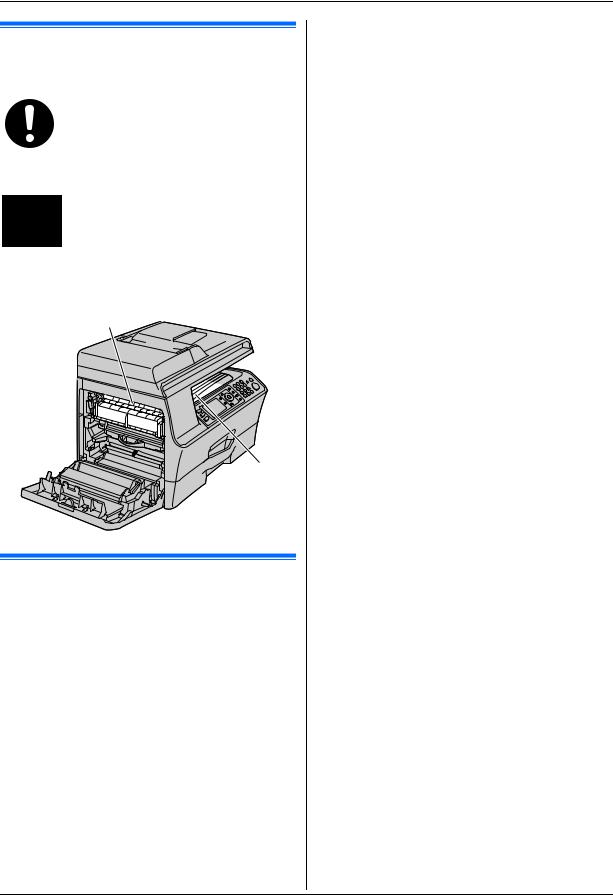
Important Information
For your safety
Laser radiation
The printer of this unit utilizes a laser. Use of controls or adjustments or performance of procedures other than those specified herein may result in hazardous radiation exposure.
Fuser unit
During or immediately after printing, the fuser unit (1) gets hot. This is normal. Do not touch the fuser unit.
Note:
LThe area near the recording paper exit (2) may also get warm. This is normal.
1
2
For best performance
Toner cartridge and drum cartridge
LWhen replacing the toner cartridge or drum cartridge, do not allow dust, water, or liquids to come
in contact with the drum. This may affect print quality.
LFor optimal performance, genuine Panasonic toner cartridges and drum cartridges are recommended. We cannot be responsible for problems that may be caused by a non-Panasonic toner cartridge or drum cartridge:
–Damage to the unit
–Poor print quality
–Improper operation
Toner cartridge
LDo not leave the toner cartridge out of the protective bag for a long time. It will decrease the toner life.
Drum cartridge
LRead the instructions on page 11 before you begin installation of the drum cartridge. After you have read
them, open the drum cartridge protective bag. The drum cartridge contains a photosensitive drum. Exposing it to light may damage the drum. Once you have opened the protective bag:
–Do not expose the drum cartridge to light for more than 3 minutes.
–Do not touch or scratch the black drum surface.
–Do not place the drum cartridge near dust or dirt, or in a high humidity area.
–Do not expose the drum cartridge to direct
sunlight.
LTo extend the life of the drum cartridge, the power switch should never be turned OFF immediately after printing. Leave the power turned ON for a minimum of 30 minutes after printing.
Location
LTo avoid malfunction, do not position the unit near appliances such as TVs or speakers which generate an intense magnetic field.
Static electricity
LTo prevent static electricity damage to the interface connectors or other electrical components inside the unit, touch a grounded metal surface before touching the components.
Environment
LKeep the unit away from electrical noise generating devices, such as fluorescent lamps and motors.
LThe unit should be kept free from dust, high temperature and vibration.
L The unit should not be exposed to direct sunlight.
LDo not place heavy objects on top of the unit. When you leave the unit unused for a long period of time, unplug this unit from the power outlet.
LThe unit should be kept away from heat sources such as heaters, kitchen stoves, etc. Damp basements
should also be avoided.
LDuring the printing process, heat is used to fuse toner onto the page. As a result, it is normal for the machine to produce an odor during and shortly after printing. Be sure to use this unit in an area with proper ventilation.
For assistance, please contact an authorized Panasonic dealer. |
3 |

Important Information
LDo not cover slots or openings on the unit. Inspect the air circulation vents regularly and remove any dust build-up with a vacuum cleaner (1).
1
Routine care
LWipe the outer surface of the unit with a soft cloth. Do not use benzine, thinner, or any abrasive powder.
Moving the unit
The unit is heavy. It is highly recommended that two people handle this unit.
When moving the unit, hold by the grips (2) on both sides.
2
2
Illegal copies
LIt is unlawful to make copies of certain documents.
Copying certain documents may be illegal in your country. Penalties of fines and/or imprisonment may be imposed on those found guilty. The following are examples of items that may be illegal to copy in your country.
–Currency
–Bank notes and checks
–Bank and government bonds and securities
–Passports and identification cards
–Copyright material or trademarks without the consent of the owner
–Postage stamps and other negotiable
instruments
This list is not inclusive and no liability is assumed for either its completeness or accuracy. In case of doubt, contact your legal counsel.
Notice:
LInstall your machine near a supervised area to prevent illegal copies from being made.
4 |
For assistance, please contact an authorized Panasonic dealer. |

Table of Contents
1. Introduction and Installation
Accessories |
|
|
1.1 |
Supplied accessories .................................... |
7 |
1.2 |
Accessory information ................................... |
7 |
Finding the Controls |
|
|
1.3 |
Button descriptions........................................ |
8 |
1.4 |
Display descriptions ...................................... |
9 |
1.5 |
Overview ..................................................... |
10 |
Installation |
|
|
1.6 |
Toner cartridge and drum cartridge............. |
11 |
1.7 |
Recording paper.......................................... |
14 |
2. Preparation |
|
|
Connections and Setup |
|
|
2.1 |
Connections ................................................ |
17 |
2.2 |
Turning the power switch ON....................... |
18 |
2.3 |
Dialing mode ............................................... |
18 |
2.4Selecting the operation mode (Scan/Copy/Fax)
|
.................................................................... |
19 |
Document Requirements |
|
|
2.5 |
Setting the original....................................... |
19 |
Volume |
|
|
2.6 |
Adjusting the volume ................................... |
21 |
Initial Programming |
|
|
2.7 |
Date and time .............................................. |
21 |
2.8 |
Your logo...................................................... |
22 |
2.9 |
Your fax number .......................................... |
23 |
2.10 |
Configuring the unit to access the LAN ....... |
23 |
2.11 |
Installing Multi-Function Station .................. |
24 |
2.12 |
Starting Multi-Function Station .................... |
26 |
3. Printer |
|
|
Printer |
|
|
3.1 |
Printing from Windows applications ............ |
28 |
3.2Printing a received email attachment
|
|
automatically (LAN connection only) ........... |
29 |
4. Scanner |
|
||
Scanner |
|
||
|
4.1 |
Scanning from the unit (Push Scan)............ |
31 |
|
4.2 |
Scanning from a computer (Pull Scan)........ |
34 |
5. |
Copier |
|
|
Copy |
|
|
|
|
5.1 |
Making a copy ............................................. |
36 |
|
5.2 |
More copying features ................................. |
38 |
6. |
Fax |
|
|
Sending Faxes |
|
||
|
6.1 |
Sending a fax manually ............................... |
42 |
|
6.2 |
Storing items for the navigator directory...... |
44 |
|
6.3 |
Sending a fax using navigator directory ...... |
45 |
|
6.4 |
Broadcast transmission ............................... |
45 |
6.5Sending an electronic document as a fax
message from your computer...................... |
47 |
Receiving Faxes
6.6Receiving a fax automatically – Auto answer
ON................................................................ |
47 |
6.7Receiving a fax manually – Auto answer OFF
|
..................................................................... |
48 |
6.8 |
Displaying a received fax document............. |
48 |
6.9 |
Using the unit with an answering machine... |
50 |
6.10 |
Junk fax prohibitor (preventing fax reception |
|
|
from undesired callers)................................. |
51 |
6.11 |
Receiving a fax on your computer................ |
52 |
6.12 |
Web fax preview (LAN connection only)....... |
52 |
7. Caller ID |
|
Caller ID |
|
7.1 Caller ID service........................................... |
54 |
7.2Viewing and calling back using caller
|
information ................................................... |
54 |
7.3 |
Erasing caller information............................. |
55 |
7.4 |
Storing caller information ............................. |
55 |
8. Distinctive Ring |
|
|
Distinctive Ring |
|
|
8.1 |
Distinctive Ring service ................................ |
56 |
8.2Using two or more phone numbers on a single
telephone line............................................... |
56 |
8.3Using three or more phone numbers on a
single telephone line .................................... |
56 |
8.4Programming the ring pattern assigned for fax
|
..................................................................... |
56 |
9. Programmable Features |
|
|
Features Summary |
|
|
9.1 |
Programming................................................ |
57 |
9.2 |
Basic features .............................................. |
58 |
9.3 |
Fax features ................................................. |
62 |
9.4 |
Copy features ............................................... |
67 |
9.5 |
PC print features .......................................... |
69 |
9.6 |
Scan features ............................................... |
71 |
9.7 |
LAN features ................................................ |
73 |
9.8 |
Network features (LAN connection only)...... |
75 |
10.Useful Information |
|
|
Useful Information |
|
|
10.1 |
Character entry ............................................ |
77 |
10.2 |
Status of the unit .......................................... |
77 |
10.3 |
Canceling the operations ............................. |
78 |
Option |
|
|
10.4 |
Lower input tray (optional)............................ |
79 |
10.5 |
Setting the lower input tray........................... |
80 |
11.Help |
|
|
Reports and Displays |
|
|
11.1 |
Report messages......................................... |
81 |
11.2 |
Display messages ........................................ |
82 |
5

Table of Contents |
|
|
Troubleshooting |
|
|
11.3 |
When a function does not work ................... |
85 |
12.Paper Jams |
|
|
Jams |
|
|
12.1 |
Recording paper jam ................................... |
94 |
12.2 |
Document jams (Automatic document feeder) |
|
|
.................................................................. |
100 |
13.Cleaning |
|
|
Cleaning |
|
|
13.1 |
Cleaning the white plates and glass.......... |
101 |
13.2 |
Cleaning the document feeder rollers........ |
102 |
14.General Information |
|
|
Printed Reports |
|
|
14.1 |
Reference lists and reports ....................... |
103 |
Specifications |
|
|
14.2 |
Specifications ............................................ |
103 |
Copyrights |
|
|
14.3 |
Information of copyrights and licenses ...... |
106 |
15.Index |
|
|
15.1 |
Index......................................................... |
116 |
6
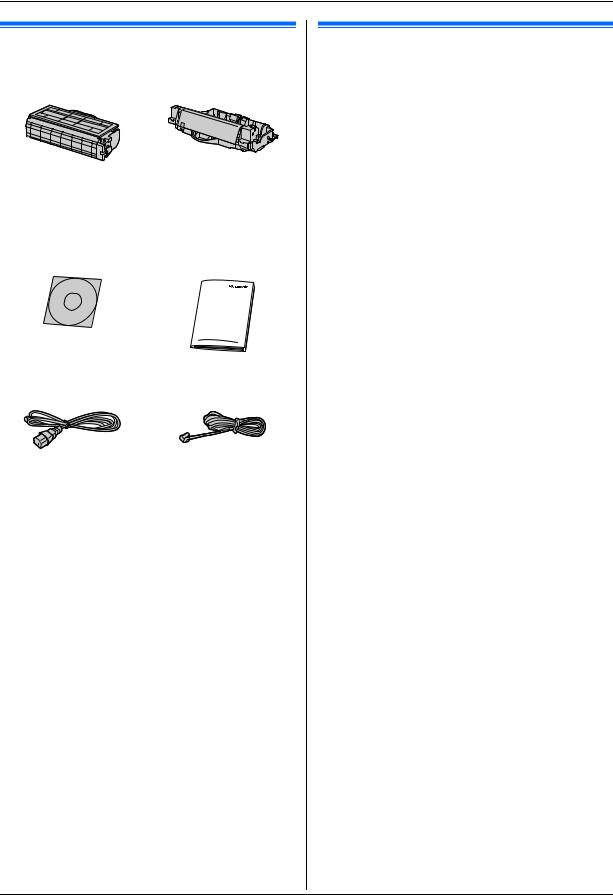
1. Introduction and Installation
1.1 Supplied accessories
1 Toner cartridge |
2 Drum cartridge |
|
(DQ-DCB020)*1 |
3 CD-ROM |
4 Quick reference guide |
(PNJKMB300Z)*1 |
(English– |
|
PNQW1864Z)*1 |
|
(Spanish– |
|
PNQW1865Z)*1 |
5 Power cord |
6 Telephone line cord |
(PNJA1021Z)*1 |
(PFJA02B002Y)*1 |
*1 Parts numbers are subject to change without notice.
Note:
LSave the original carton and packing materials for future shipping and transportation of the unit.
LAfter unpacking the product, take care of the packing materials and/or power plug cap appropriately.
1.2 Accessory information
Accessories for this unit can be ordered online, by fax, or by telephone.
To ensure that the unit operates properly, we recommend the use of Panasonic toner cartridge and drum cartridge.
■ Replacement accessory
–Toner cartridge
L Model No. (Part No.): DQ-TCB008
LPrints about 8,000 pages at ISO/IEC 19752 standard page.
–Drum cartridge
LModel No. (Part No.): DQ-DCB020
■ Optional accessory
–Lower input tray (page 79)
L Model No. (Part No.): DA-LCB350
Note:
LISO/IEC 19752 standard is as follows:
–Environment: 23 ±2 °C (73 ±3 °F) / 50 ±10% RH
–Print mode: Continuous printing
For assistance, please contact an authorized Panasonic dealer. |
7 |

1. Introduction and Installation
1.3 Button descriptions
A B |
CD EF |
G H |
I |
JKL M NOP |
Q |
A {Copy}
L To switch to copy mode (page 19, 36).
B {Scan}
L To switch to scan mode (page 19, 31).
C {Advance}*1
L To switch to the basic/advance settings.
D {Menu}
L To start or exit programming.
E {Caller ID}
L To use Caller ID features (page 54).
F {Redial}{Pause}
LTo redial the last number dialed. If the line is busy when you send a fax, the unit will automatically
redial the number 1 time.
L To insert a pause during dialing.
G {Fax Auto Answer}
LTo turn the auto answer setting ON/OFF (page 47).
H {Stop}
L To stop an operation or programming session.
I {Fax}
L To switch to fax mode (page 19, 42).
J {Duplex}
L To make duplex copies (page 38).
L To scan or send 2-sided originals (page 33, 43).
K {Back}*1
L To return to the previous display. L To erase a character/number.
L Navigator key*1
L To select desired settings.
L To adjust the volume (page 21).
L To search for a stored item (page 45).
M {Set}*1
L To store a setting during programming.
N {Monitor}
LTo initiate dialing.
When you press {Monitor} while receiving a call, you will be able to hear the other party, but the other party will not be able to hear you.
O {Flash}
LTo access special telephone services or for transferring extension calls.
P {Tone}
LTo change from pulse to tone temporarily during dialing when your line has rotary/pulse service.
Q {Start}
L To copy a document (page 36).
L To scan a document (push scan) (page 31). L To send a fax (page 42).
*1 See page 9 for details.
8 |
For assistance, please contact an authorized Panasonic dealer. |

1. Introduction and Installation
1.4 Display descriptions
A |
B |
C |
|
|
Copy |
|
|
Basic |
|
|
|
|
Copies |
|
01 |
|
Zoom |
|
100% |
|
Contrast |
|
|
|
Resolution |
|
Text/Photo |
|
Page Layout |
|
Disabled |
|
Select Menu. |
Copy: |
|
|
|
D |
|
A Feature mode
L Displays the feature mode status.
B Status bar
L Displays the operation mode (page 19). L Displays date and time (page 21).
L Displays error messages (page 82).
C Main display
L Displays the feature settings.
L Displays received fax documents (page 48). L Displays error messages (page 82).
D Button operation guide
LDisplays the available buttons for the corresponding operations.
Note:
LThe displayed menu items may be different depending on the operation. To select a menu item not shown on the current page, scroll up or down by using the navigator key.
1.4.1 Display and buttons
The following buttons can be used to navigate through operations or to select items shown on the display.
A B
C D
A {Advance}
LTo change the display between basic and advanced feature modes.
L To change the feature settings during operation.
B {Set}
L To store a setting during programming.
LTo place “,” and select the item, or remove “,” and cancel the selected item.
C {Back}
L To return to the previous display.
LTo exit an operation while maintaining the settings.
D Navigator key
L To select the item shown on the display.
L To select features or feature settings during programming.
L To navigate to the next operation.
L To scroll a displayed image (page 48).
For assistance, please contact an authorized Panasonic dealer. |
9 |

1. Introduction and Installation
1.5 Overview
1.5.1 Front view
1 2 3 4 5
6
k
7
j
8 9
1ADF (Automatic Document Feeder) cover
2Document guides
3Document tray
4Document exit
5Document cover
6Document entrance
7Left cover
8Left cover open lever
9Standard input tray
j Recording paper exit
LThe paper exit area of this unit can hold up to approximately 100 sheets of printed paper (the number of sheets may vary depending on the usage environment). Remove the printed paper before the recording paper exit becomes full.
k A4/letter paper stacker
LWe recommend opening the A4/letter paper stacker when using A4 or letter-size recording
paper. Do not open it when using legal-size recording paper.
L For A4-size, slide the stacker to the rightmost position, then open it.
For letter-size, just open the stacker (no need to slide it).
LThe A4/letter paper stacker may not be shown in all illustrations.
1.5.2 Rear view
A
B
C
D E F H
 G
G
ATelephone line jack
BExternal telephone jack
CSpeaker
DUSB interface connector
EPower switch
FLAN interface connector
L 10Base-T/100Base-TX
GLED
HPower inlet
10 |
For assistance, please contact an authorized Panasonic dealer. |

1. Introduction and Installation
1.6 Toner cartridge and drum cartridge
The supplied toner cartridge is a starter toner cartridge.
Caution:
LRead the following instructions before you begin installation. After you have read them, open the drum cartridge protective bag. The drum cartridge contains a photosensitive drum. Exposing it to light may damage the drum. Once you have opened the protective bag:
–Do not expose the drum cartridge to light for more than 3 minutes.
–Do not touch or scratch the black drum surface inside of the drum cartridge.
–Do not place the drum cartridge near dust or dirt, or in a high humidity area.
–Do not expose the drum cartridge to direct sunlight.
LDo not leave the toner cartridge out of the protective bag for a long time. It will decrease the
toner life.
LWe cannot be responsible for any damage to the unit or degradation of print quality which may occur from the use of a non-Panasonic toner cartridge and drum cartridge.
L Do not add toner to the toner cartridge.
1 Remove the toner cartridge (1) and drum cartridge (2) from the protective bags.
1 2
2Shake the toner cartridge horizontally more than 5 times.
3Detach the protective cover (3) from the toner cartridge, and remove the protective sheet (4) from the drum cartridge.
LDo not touch or scratch the black drum or toner surfaces.
3
4
4Insert the toner cartridge (5) into the drum cartridge (6) from the upper angle.
5
6
5Push down the toner cartridge (7) to lock into place. L Make sure that the triangles (8) match to install
the toner cartridge correctly.
8
7
For assistance, please contact an authorized Panasonic dealer. |
11 |
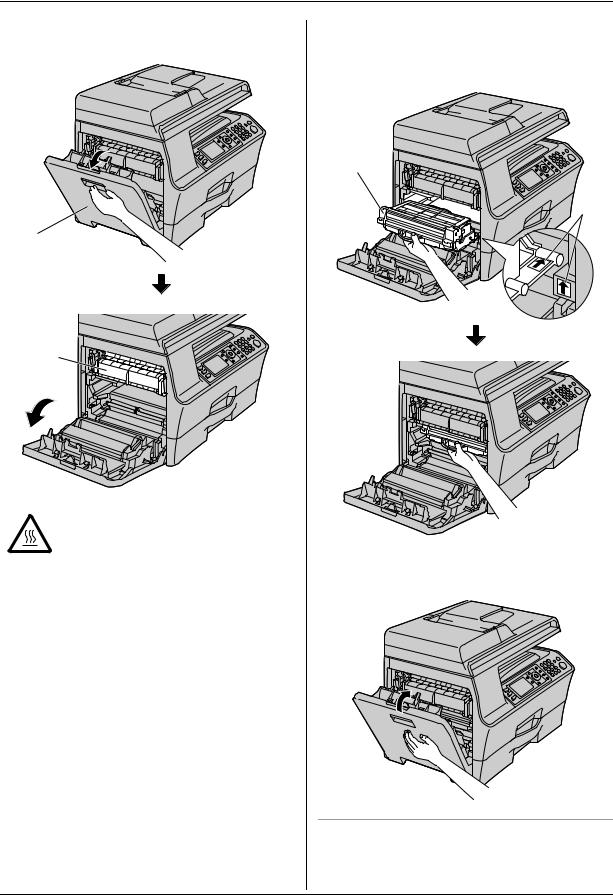
1. Introduction and Installation
6Hold the left cover release lever (9), and then pull open the left cover (j).
9


j
k
Caution:
L During or immediately after printing, the fuser unit (k) gets hot. Wait until the fuser unit cools down.
7Install the drum and toner unit (l) by holding the center handle.
L Make sure that the arrows (m) match to install the drum and toner unit correctly.
l
m
8 Close the left cover.
When to replace the toner cartridge and the drum cartridge
When the display shows the following, replace the toner cartridge.
12 |
For assistance, please contact an authorized Panasonic dealer. |

1. Introduction and Installation
–“Change Supplies Toner Low”
–“Change Supplies Toner Empty”
Note:
LTo check the drum life and quality, please print the printer test list (page 103) and refer to page 105 for information on the drum life. If printing quality is still
poor or “Replace Drum” appears on the display, replace the toner cartridge and drum cartridge.
L To ensure that the unit operates properly, we recommend the use of Panasonic toner cartridge and drum cartridge. See page 7 for accessory information.
LSee page 104 for information on toner life and drum life.
Cleaning the drum cartridge
Important:
LIf the groove of the drum cartridge is dirty, lines or dirty patterns may appear on printed sheets. Be sure to remove any toner remaining on the inside of the drum cartridge to maintain the print quality.
LA cleaner for the drum cartridge is supplied with the replacement toner cartridge. If you replace only the toner cartridge, clean the drum cartridge using the
cleaner.
LInsert the cleaner (n) into the left groove (o) and move it from side to side at least 3 times to clean the inside of the drum cartridge. Repeat this for the right groove (p).
n
o p
Note:
LBe sure to clean all the way to the edge of each groove.
Waste disposal method
Waste material should be disposed of under conditions which meet all national and local environmental regulations.
Toner save feature
If you want to reduce toner consumption, set the toner save setting to ON (feature #482 on page 61). The toner cartridge will last approximately 20 % longer. This feature may lower the print quality.
For assistance, please contact an authorized Panasonic dealer. |
13 |

1. Introduction and Installation
1.7 Recording paper
The standard input tray unit can hold:
–Up to 520 sheets of 75 g/m2 (20 lb) paper.
–Up to 470 sheets of 80 g/m2 (21 lb) paper.
–Up to 410 sheets of 90 g/m2 (24 lb) paper.
–Up to 100 sheets of 105 g/m2 (28 lb) paper.
–Up to 25 transparencies.*1
–Up to 25 labels.*1
*1 Only when using the unit as a printer. See page 29 for details.
LThe unit is set for printing letter-size plain paper by default.
–To use other paper sizes, change the recording paper size setting (feature #380 on page 59).
–To use thin or thick paper, change the recording paper type setting (feature #383 on page 60).
Note for recording paper:
LWe recommend that you test paper (especially special sizes and types of paper) on the unit before
purchasing large quantities.
LDo not use the following types of paper:
–Paper with cotton and/or fiber content that is over 20 %, such as letterhead paper or paper used for resumes
–Extremely smooth or shiny paper, or paper that is highly textured
–Coated, damaged or wrinkled paper
–Paper with foreign objects attached, such as tabs or staples
–Paper that has dust, lint or oil stains
–Paper that will melt, vaporize, discolor, scorch or emit dangerous fumes near 200 °C (392 °F), such as vellum paper. These materials may transfer onto the fusing roller and cause damage.
–Moist paper
–Inkjet paper
LSome paper is designed to be printed on only one side. Try printing on the other side of the paper if you are not happy with the print quality, or if misfeeding
occurs.
LFor proper paper feeding and best print quality, we recommend using long-grained paper.
LDo not use paper of different types or thicknesses at the same time. This may cause paper jams.
L Do not use paper printed from this unit for doublesided printing with other copiers or printers. This may cause paper jams.
L To avoid curling, do not open paper packs until you are ready to use the paper. Store unused paper in the original packaging, in a cool and dry location.
LFor customers who live in high humidity areas: Please be sure to store paper in an air-conditioned room at all times. If you print using moist paper, it may cause paper jam.
1Pull the standard input tray (1) until it clicks into place, then pull it completely out, lifting the front part of the tray.
 1
1
2Before loading a stack of paper, fan the paper to prevent paper jams.
3Pinch the right side of the recording paper guide (2), then slide it to match the paper size mark. Pinch the front and back recording paper guides (3) at the same time, then slide them together to match the paper size mark.
2
3
4 Load the paper, print-side up (4).
14 |
For assistance, please contact an authorized Panasonic dealer. |
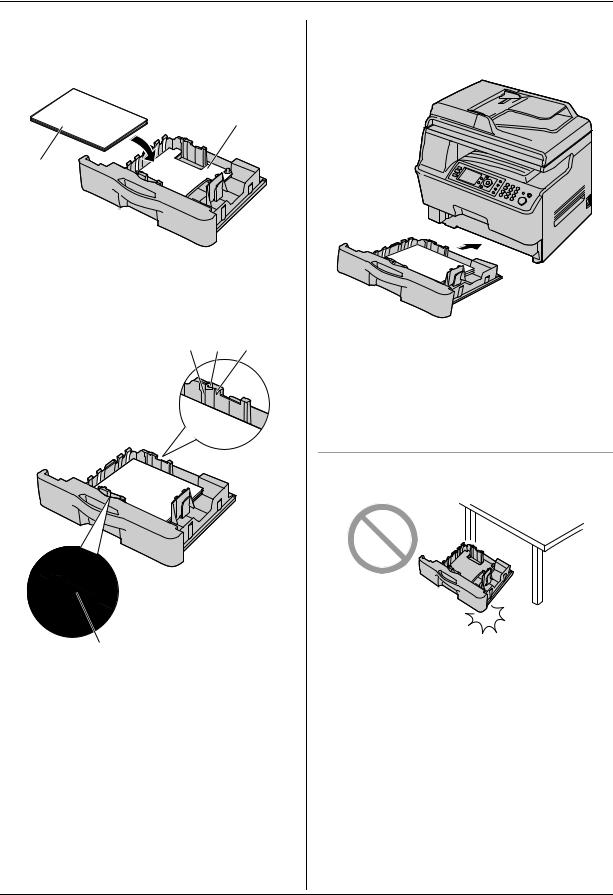
1. Introduction and Installation
Important:
LPush down to lock the plate (5) in the standard input tray, if it has come up.
5
4
LMake sure that the recording paper guides (6) are at the paper size mark and the recording paper is under the paper limit mark (7). The paper should not be loaded over the tab (8).
6 8 7
6
5Insert the standard input tray into the unit, lifting the front part of the tray. Then push it completely into the unit.
Note:
LIf the paper is not loaded correctly, re-adjust the paper guides, or the paper may jam.
LIf the standard input tray does not close, the plate in the standard input tray may not be in the locked position. Push the paper down and make sure that the paper is lying flat in the standard input tray.
Caution for the standard input tray
L Do not drop the standard input tray.
LHold the standard input tray with both hands when removing or installing. The standard input tray weighs approximately 4.8 kg (10.6 lb) when fully loaded with recording paper.
For assistance, please contact an authorized Panasonic dealer. |
15 |

1. Introduction and Installation
Do not touch the plate (9) on the left side of the standard input tray.
9
Approx. 4.8 kg (10.6 lb)
16 |
For assistance, please contact an authorized Panasonic dealer. |

2. Preparation
2.1 Connections
Caution:
LWhen you operate this product, the power outlet should be near the product and easily accessible.
8
9 |
j |
|
3 |
7 |
|
5

6 1
 2
2
k 4
1 Power cord
LConnect to a power outlet (120 V, 60 Hz).
2 Telephone line cord
L Connect to a single telephone line jack (RJ11C). 3 [EXT] jack
LYou can connect an answering machine or an extension telephone. Remove the stopper if attached.
4Answering machine (not supplied)
5To the Internet
6Network router/Network hub (not supplied) L Also connect networked computers.
7LAN cable (not supplied)
LTo assure continued emission limit compliance, use only shielded LAN cable (category 5 straight cable).
IMPORTANT NOTICE FOR THE USB
CONNECTION
LDO NOT CONNECT THE UNIT TO A COMPUTER WITH THE USB CABLE UNTIL PROMPTED TO DO SO DURING THE SETUP OF MULTI-FUNCTION STATION (page 24).
Note:
LDo not place any objects within the following distance:
–Left side (8): 40 cm (153/4 inches)
–Right side (9) and back side (j): 10 cm (4 inches)
LIf any other device is connected to the same telephone line, this unit may disturb the network condition of the device.
LA telephone handset cannot be connected directly to this unit. To talk to the other party, please connect an extension telephone.
Using surge protectors
LThe warranty does not cover damage due to power line surges or lightning. For additional protection, we recommend using a surge protector (k).
Using network router/network hub
L We recommend using network routers/network hubs (6) under secure network environments. Consult your network administrator for firewall settings, etc.
LThe warranty does not cover damage due to security problems or any inconveniences relating to it.
If the unit shares a single telephone line with a DSL service
Fax transmission/reception may be unreliable, noise interference may be heard during telephone conversations, or Caller ID (page 54) may not function properly. Please attach a DSL filter (l) to the telephone line cord of the unit to prevent this. A DSL filter may be available from your DSL service provider.
l
For assistance, please contact an authorized Panasonic dealer. |
17 |
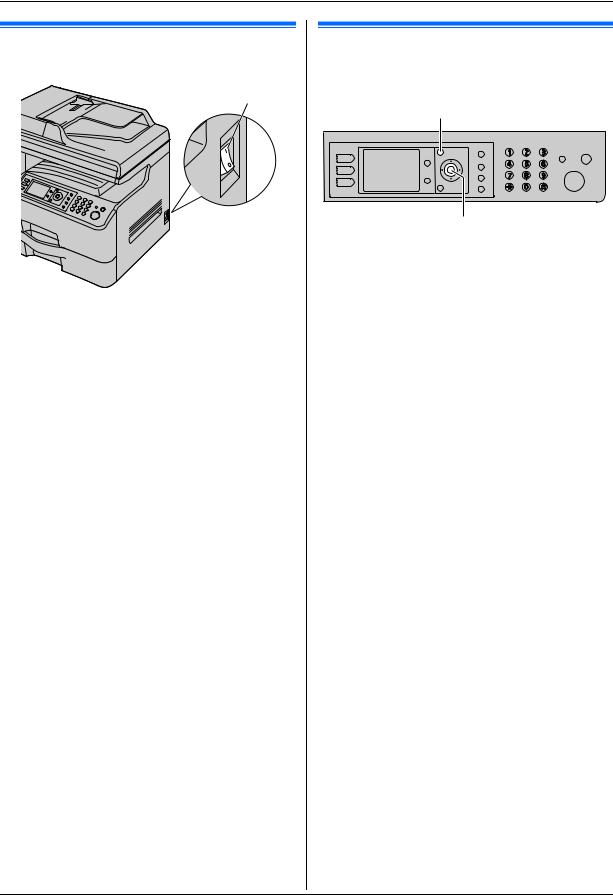
2. Preparation
2.2 Turning the power switch ON |
2.3 Dialing mode |
Turn the power switch to the ON position (1). |
If you cannot dial (page 42), change this setting |
|
according to your telephone line service. |
1 |
{Menu} |
|
{Set}
1 {Menu}
2 Press {#}{1}{2}{0} to display “Dialing Mode”.
3 Press {1} or {2} to select the desired setting. {1} “Pulse”: For rotary/pulse dial service. {2} “Tone” (default): For tone dial service.
4 {Set}
5 Press {Menu} to exit.
18 |
For assistance, please contact an authorized Panasonic dealer. |
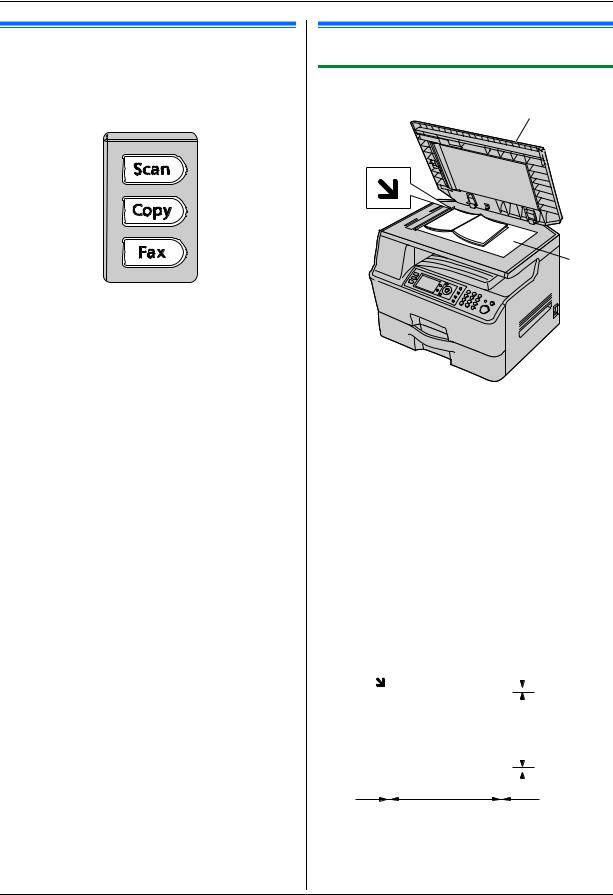
2. Preparation
2.4 Selecting the operation mode (Scan/Copy/Fax)
You can select the desired mode by pressing one of the following buttons.
–{Scan}: Select this mode when using the unit as a scanner (page 31).
–{Copy}: Select this mode when using the unit as a copier (page 36).
–{Fax}: Select this mode when using the unit as a fax machine (page 42).
Note:
L The default operation mode is the copy mode.
LYou can change the default operation mode (feature #463 on page 60) and the timer before returning to the default operation mode (feature #464 on page 60).
2.5 Setting the original
2.5.1 Using the scanner glass
1
 2
2
1Open the document cover (1).
2Place the document FACE DOWN on the scanner glass (2), aligning the top left of the document with the corner where the m mark is positioned.
3Close the document cover.
Note:
LConfirm that there are no documents in the automatic document feeder.
L Place the original onto the scanner glass gently. To avoid malfunction, do not press down too firmly.
L If the original is a thick book, do not close the document cover.
LConfirm that any ink, paste or correction fluid has dried completely.
LEffective scanning area is shown by the shaded area:
Effective scanning area
|
|
|
|
|
|
|
|
|
|
|
|
4 mm |
|
|
|
|
|
|
|
|
|
|
|
|
|
|
|
|
|
|
|
|
|
|
(5/32") |
|||
|
|
|
|
|
|
|
|
|
|
|
208 mm |
|
|
|
|
|
|
|
|
|
|
(8 3/16") |
|||
|
|
|
|
|
|
|
|
|
|
|
|
4 mm |
|
|
|
|
|
|
|
|
|
|
|
|
|
|
|
|
|
|
|
|
|
|
|
|
|
|
|
|
|
|
|
|
|
|
|
|
(5/32") |
||
|
|
|
|
|
|
|
|
|||||
4 mm |
|
|
348 mm |
|
|
|
|
|
4 mm |
|||
|
|
|||||||||||
|
|
|
|
|
||||||||
(5/32") |
(13 11/16") |
|
|
(5/32") |
||||||||
For assistance, please contact an authorized Panasonic dealer. |
19 |

2. Preparation
2.5.2 Using the automatic document feeder
1
1Insert the document (up to 50 pages) FACE UP into the feeder until a single beep is heard.
2Adjust the width of the document guides (1) to fit the actual size of the document.
Note:
L Confirm that there are no documents on the scanner glass.
LConfirm that any ink, paste or correction fluid has dried completely.
L Remove clips, staples or other fasteners.
LDo not insert the following types of documents (Make a copy of the document using the scanner glass and set the copy instead.):
–Chemically treated paper such as carbon or carbonless duplicating paper
–Electrostatically charged paper
–Badly curled, creased or torn paper
–Paper with a coated surface
–Paper with printing on the opposite side that can be seen through the other side, such as newsprint
LThe total height of the documents when laid flat, must be less than 5 mm (3/16"). If the documents exceed the capacity of the automatic document
feeder, they may fall or cause a jam in the feeder.
LTo set a document with a width of less than 210 mm (8 1/4"), we recommend using the scanner glass to
copy the original document onto A4 or letter-size paper, then setting the copied document for better results.
LDo not set documents that do not satisfy the requirements of size and weight. Make a copy of the document using the scanner glass and set the copy.
LAvailable document size, document weight and effective scanning area are as follows:
Minimum document size
128 mm (5")
128 mm (5")
Maximum document size
|
|
|
|
|
mm |
5/8") |
|
|
600 |
(23 |
|
|
|
|
|
|
|
|
|
216 mm (8 1/2")
Effective scanning area
 4 mm (5/32")
4 mm (5/32")
|
|
|
|
|
|
|
|
4 mm (5/32") |
|
|
|
|
|
|
|
|
|
|
|
|
|
|
|
|
|
|
4 mm (5/32") |
|
|
|
|
|
4 mm (5/32") |
||
|
|
|
|
|
||||
|
208 mm (8 3/16") |
|
||||||
|
|
|
|
|
|
|
|
|
|
216 mm (8 1/2") |
|||||||
L Shaded area will be scanned.
LWhen using the unit as a scanner (page 31, 34), the effective scanning length depends on the selected paper size.
Document weight
L Single sheet:
45 g/m2 to 90 g/m2 (12 lb to 24 lb) L Multiple sheets:
60 g/m2 to 80 g/m2 (16 lb to 21 lb)
20 |
For assistance, please contact an authorized Panasonic dealer. |

2. Preparation
2.6 Adjusting the volume
Important:
LBefore adjusting the volume, set the operation mode to fax mode. If the {Fax} light is OFF, turn it ON by pressing {Fax}.
{Fax} {V}{^}{<}{>}
Ringer volume
1.Press {V} or {^} repeatedly to select “Ringer Volume”.
2.Press {<} or {>}.
To turn the ringer OFF
1.Press {V} or {^} repeatedly to select “Ringer Volume”.
2.Press {<} repeatedly to display “Ringer Off” in the status bar.
L The unit will not ring.
L To turn the ringer back ON, press {>}.
Monitor volume
1.While using the monitor, press {V} or {^} repeatedly to select “Monitor Volume”.
2.Press {<} or {>}.
2.7 Date and time
We recommend you to set the date and time. The other party will receive your unit’s date and time as the header information.
{Menu}
{Set} {V}{^}{<}{>}
1{Menu} i{#}{1}{0}{1} i{Set}
2Enter the current month/date/year/hour/minute.
Example: August 10, 2009 10:15 PM (12 hour clock format)
1.Press {V} or {^} repeatedly to select “Date”. i{<}/{>}
2.Press {0}{8} {1}{0} {2}{0}{0}{9}.
M:08/D:10/Y:2009
3.{Set}
4.Press {V} or {^} repeatedly to select “Time”. i{<}/{>}
5.Press {1}{0} {1}{5}, then press {V} or {^} repeatedly to select “PM”.
10:15PM
6. {Set}
3 Press {Menu} to exit.
Note:
LYour unit’s date and time will be used as the header information for the following:
–When sending as an attached file to an email destination directly from this unit (Scan to email address) (page 32).
–When sending faxes (page 42).
LIf the date and time is not set correctly, the other party will receive an incorrect date and time as their header. This may confuse the other party.
To correct a mistake
Press {<} or {>} to move the cursor to the incorrect number, and make the correction.
If you have subscribed to a Caller ID service
The date and time will be automatically set according to the received caller information.
LIf the time has not previously been set, Caller ID will not adjust the clock.
For assistance, please contact an authorized Panasonic dealer. |
21 |

2. Preparation
LYou can turn this feature OFF (feature #226 on page 59).
2.8 Your logo
You can program your logo (name, company name, etc.) so that it appears on the top of each page sent.
{Menu}
{Back} {Set} {<}{>}
1{Menu} i{#}{1}{0}{2} i{Set}
2Enter your logo, up to 30 characters (see page 77 for character entry). i{Set}
3Press {Menu} to exit.
To correct a mistake
Press {<} or {>} to move the cursor to the incorrect character, and make the correction.
L To erase all characters, press and hold {Back}.
22 |
For assistance, please contact an authorized Panasonic dealer. |

2. Preparation
2.9 Your fax number
You can program your fax number so that it appears on the top of each page sent.
{Menu} {Flash}
{Back} {Set} {<}{>}
1{Menu} i{#}{1}{0}{3} i{Set}
2Enter your fax number, up to 20 digits. L To enter a “+”, press {*}.
L To enter a space, press {#}.
L To enter a hyphen, press {Flash}. L To erase a number, press {Back}.
3{Set}
4Press {Menu} to exit.
To correct a mistake
Press {<} or {>} to move the cursor to the incorrect number, and make the correction.
L To erase all numbers, press and hold {Back}.
2.10 Configuring the unit to access the LAN
You can print documents, scan documents, receive faxes or send faxes using a computer connected to the LAN. To enable these features, you need to set the IP address, subnet mask, and default gateway in the unit.
Important:
LConsult your network administrator when setting the IP address, subnet mask, and default gateway.
2.10.1 Setting up automatically with a DHCP server
Your situation:
–When only one unit is connected to the LAN.
If your network administrator manages the network with a DHCP (Dynamic Host Configuration Protocol) server, it will automatically assign an IP (Internet Protocol) address, subnet mask, and default gateway to the unit.
1After connecting the LAN cable to the unit and the computer, turn the power switch ON.
L The IP address, subnet mask, and default gateway will be set automatically.
2Install Multi-Function Station on the computer that you want to use it with. See page 24 for details.
Note:
LYou can connect two or more units and assign IP addresses automatically with a DHCP server, but we recommend assigning static IP addresses manually for each unit to avoid network access and configuration troubles.
2.10.2 Setting up manually
Your situation:
–When your network administrator does not manage the network with a DHCP server.
–When two or more units are connected to the LAN.
You need to assign an IP address, subnet mask, and default gateway manually.
1{Menu}
2Press {#}{5}{0}{0} to display “DHCP”.
3Press {0} to select “Disabled”. i{Set}
4Set each item.
For the IP address:
1.Press {5}{0}{1} to display “IP Address”.
2.{Set} iEnter the IP address of the unit. i
{Set}
For the subnet mask:
1.Press {5}{0}{2} to display “Subnet Mask”.
2.{Set} iEnter the subnet mask of the network. i{Set}
For assistance, please contact an authorized Panasonic dealer. |
23 |

2. Preparation
For the default gateway:
1.Press {5}{0}{3} to display “Default Gateway”.
2.{Set} iEnter the default gateway of the network. i{Set}
5Press {Menu} to exit.
6Install Multi-Function Station on the computer that you want to use it with. See page 24 for details.
To correct a mistake in the IP address, subnet mask, or default gateway
Press {<} or {>} to move the cursor to the incorrect number, and make the correction.
2.10.3 Setting the computer for PC fax reception
You need to select the computer that will be used for receiving faxes.
Important:
LMake sure the PC fax setting is set to “Always” or “Connected” beforehand (feature #442 on
page 65).
LMake sure the fax preview mode is turned OFF beforehand (feature #448 on page 52).
1{Menu} i{#}{4}{4}{3} i{Set}
2Press {V} or {^} repeatedly to select the desired computer. i{Set}
3Press {Menu} to exit.
Note:
LIf the unit is not connected to the LAN, the computer connected to the unit by USB is assigned as the default computer for PC fax reception.
LTo select the desired computer easily, change the PC name beforehand (page 27).
2.11 Installing Multi-Function
Station
2.11.1 Required computer environment
Panasonic Multi-Function Station software enables the unit to carry out the following functions:
–Printing on plain paper, thin and thick paper, transparencies and labels
–Scanning documents and converting an image into text with Readiris OCR software
–Scanning from other applications for Microsoft® Windows® that support TWAIN scanning and WIA scanning (Windows XP/Windows Vista®, USB connection only)
–Storing, editing or erasing items in directories using your computer
–Programming the features using your computer
–Sending, receiving fax documents using your computer
To use Multi-Function Station on your computer, the following are required:
Operating System:
Windows 98/Windows Me/Windows 2000/Windows XP/Windows Vista
CPU:
Windows 98/Windows Me/Windows 2000: Pentium® y or higher processor
Windows XP: Pentium z or higher processor Windows Vista: Pentium 4 or higher processor
RAM:
Windows 98/Windows Me: 64 MB (128 MB or more recommended)
Windows 2000/Windows XP: 128 MB (256 MB or more recommended)
Windows Vista: 512 MB (1,024 MB or more recommended)
Other Hardware:
CD-ROM drive
Hard disk drive with at least 150 MB of available space USB interface
LAN interface (10Base-T/100Base-TX)
Other:
Internet Explorer® 5.0 or later
Warning:
LTo assure continued emission limit compliance;
–use only shielded USB cable (Example: HiSpeed USB 2.0 certified cable).
–use only shielded LAN cable (category 5 straight
cable).
LTo protect the unit, use only shielded USB cable in areas where thunderstorms occur.
Note:
LA USB cable is not supplied. Please purchase a shielded Type-A male/Type-B male USB cable.
24 |
For assistance, please contact an authorized Panasonic dealer. |
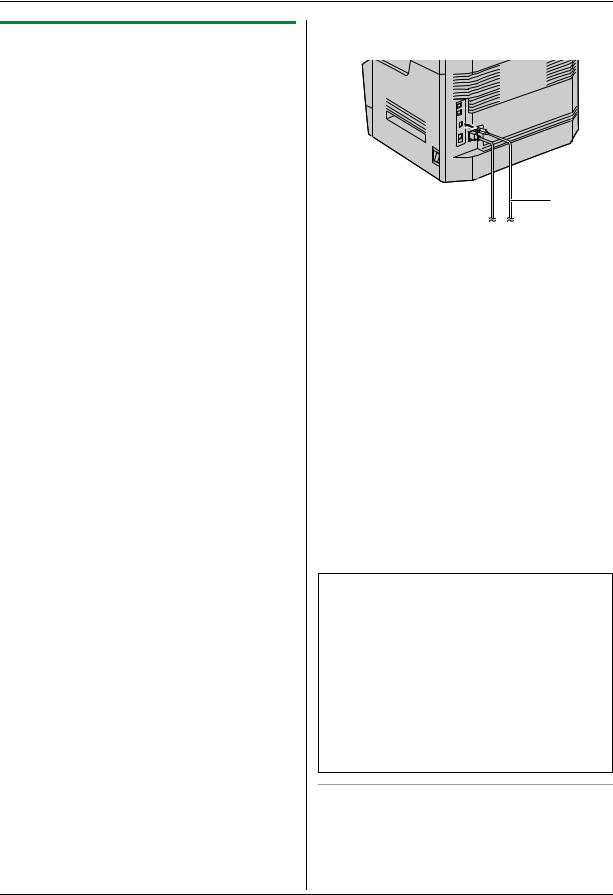
2. Preparation
2.11.2 Installing Multi-Function Station on a computer
LInstall Multi-Function Station (CD-ROM) before connecting the unit to a computer with the USB cable. If the unit is connected to a computer with the USB cable before installing Multi-Function
Station, the [Found New Hardware Wizard] dialog box will appear. Click [Cancel] to close it.
L The screenshots shown in these instructions are for Windows XP and are included for reference only.
L The screenshots shown in these instructions may differ slightly from those of the actual product.
L Software features and appearance are subject to change without notice.
L If you are also using KX-MB271/KX-MB781/KX-
FLB881, see page 93.
1 Start Windows and exit all other applications.
LFor Windows 2000, Windows XP and Windows Vista users, you must be logged in as an administrator in order to install Multi-Function Station.
2Insert the supplied CD-ROM into your CD-ROM drive.
L If the [Select Language] dialog box appears, select the language that you want to use with this software. Click [OK].
L If the installation does not start automatically: Click [Start]. Choose [Run...]. Type “D:\Install”
(where “D” is the drive letter of your CD-ROM drive). Click [OK].
(If you are not sure what the drive letter is for your CD-ROM drive, use Windows Explorer and look for the CD-ROM drive.)
3[Easy Installation]
L The installation will start automatically.
4When the setup program starts, follow the on-screen instructions.
L Readiris OCR software (page 32) and Device Monitor (page 78) will also be installed.
5The [Connect Type] dialog box appears.
For USB connection:
1.[Connect directly with a USB cable.] i[Next] L The [Connect Device] dialog box will appear.
2.Connect the unit to a computer with the USB cable (1), then click [Next].
1
L If the unit is connected to your computer, the model name will be automatically detected.
LYou can change the name of the unit if necessary.
3.Click [Install], then follow the on-screen instructions.
LThe files will be copied to your computer.
For LAN connection:
1. [Connect via the Network.] i[Next]
LThe [Select a Network Device] dialog box will appear.
2.Check [Select in the searched list] and select the unit from the list.
LIf the name of the desired unit is not displayed on the list, and the IP address for the unit has been assigned, check [Direct input] and enter the IP address.
3.[Next]
LYou can change the name of the unit if necessary.
4.Click [Install], then follow the on-screen instructions.
LThe files will be copied to your computer.
Important notice
If you are using Windows XP or Windows Vista, a message may appear after connecting the unit with the USB cable. This is normal and the software will not cause any difficulties with your operating system. You can continue the installation with no problem. This kind of message is displayed:
LFor Windows XP users
“The software you are installing for this hardware
has not passed Windows Logo testing to verify its compatibility with Windows XP.”
LFor Windows Vista users
“Would you like to install this device software?”
To view or install the operating instructions data
1.Start Windows and insert the supplied CD-ROM into your CD-ROM drive.
2.Click [Operating Instructions], then follow the onscreen instructions to view or install the operating instructions in PDF format.
For assistance, please contact an authorized Panasonic dealer. |
25 |
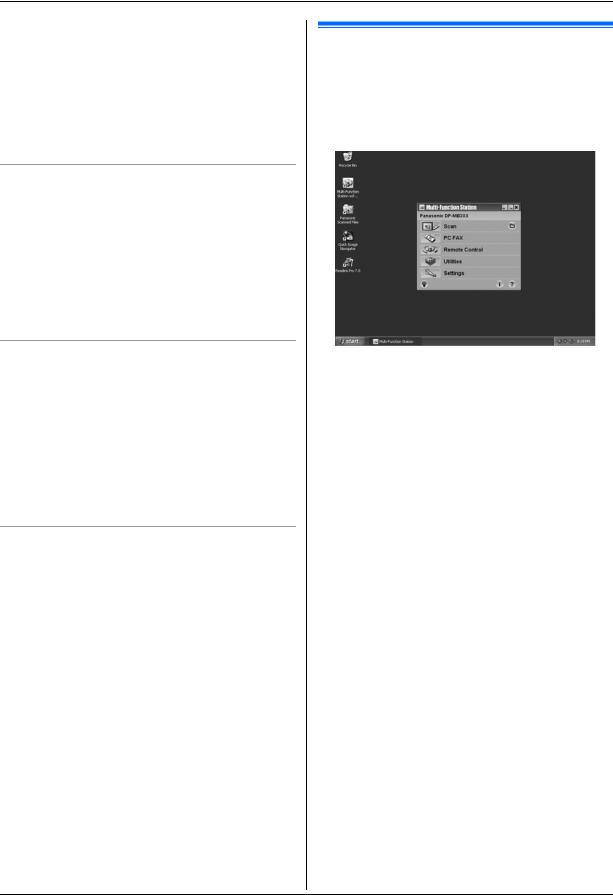
2. Preparation
LAdobe® Reader® is required to view the operating instructions.
Note:
LIf the screen prompts you to insert the CD-ROM for the operating system when installing Multi-Function Station, insert it into your CD-ROM drive.
LIf you install the operating instructions, you can view it anytime by clicking [o] on the Multi-Function Station launcher.
To use another unit with the computer
You need to add the printer driver for each unit, as follows.
1.Start Windows and insert the supplied CD-ROM into your CD-ROM drive.
2.[Modify] i[Add Multi-Function Station Driver]. Then follow the on-screen instructions.
Note:
LYou cannot connect more than one unit to the same computer at the same time (USB connection only).
To modify the software (To add or uninstall each component)
You can select the components to install or uninstall anytime after the installation.
For Windows 2000, Windows XP and Windows Vista users, you must be logged in as an administrator in order to modify Multi-Function Station.
1.Start Windows and insert the supplied CD-ROM into your CD-ROM drive.
2.[Modify] i[Modify Utilities]. Then follow the onscreen instructions.
To uninstall the software
For Windows 2000, Windows XP and Windows Vista users, you must be logged in as an administrator in order to uninstall Multi-Function Station.
[Start] i[All Programs] or [Programs] i [Panasonic] ithe unit’s name i[Uninstall]. Then follow the on-screen instructions.
2.12 Starting Multi-Function
Station
[Start] i[All Programs] or [Programs] i [Panasonic] ithe unit’s name i[Multi-Function Station]
L Multi-Function Station will appear.
[Scan] (page 34)
L To scan and display the scanned images. L To scan and create an image file.
L To scan and send by email.
L To scan and convert an image into editable text data.
[PC FAX]
L To send a document created on the computer as a fax message (page 47).
LTo display a fax document received on the computer (page 52).
[Remote Control] (page 77)
L To program the features.
L To store, edit or erase items in directories.
L To view items in the journal report or Caller ID list. L To store caller information into directories.
L To store or erase items for broadcast transmission.
[Utilities]
LTo start the Quick Image Navigator (Windows 2000/Windows XP/Windows Vista)/the MultiFunction Viewer (Windows 98/Windows Me) (page 34).
L To start the Device Monitor (page 78). L To start the OCR application (page 32).
LTo start the configuration web page (page 57, 78) (LAN connection only).
[Settings] (page 27)
L To change the general settings.
L To change the settings for scanning.
LTo change the folder for saving the received fax documents (page 49).
[o]
L For detailed instructions on Multi-Function Station. L To view operating instructions.
26 |
For assistance, please contact an authorized Panasonic dealer. |

2. Preparation
[p]
L To display usage tips.
[n]
L To display information about Multi-Function Station.
Note:
L You can confirm if the unit is connected to your computer by using Device Monitor (page 78).
LComputer features (printing, scanning, etc.) may not function properly in the following situations:
–When the unit is connected to a computer that was custom-built by the user.
–When the unit is connected to the computer via a PCI card or other expansion card.
–When the unit is connected to another piece of hardware (such as a USB hub or interface adapter) and not connected directly to the computer.
To change the settings
You can change the settings for Multi-Function Station beforehand.
1.Select [Settings] from Multi-Function Station.
2.Click the desired tab and change the settings. i
[OK]
[General]
–[Launcher display setting]: To select the display type of the launcher.
–[OCR Path]: To select the OCR software.
–[PC name list up on device] (LAN connection only): To select whether or not your computer name is displayed on the unit.
–[PC name] (LAN connection only): The computer name that will be displayed on the unit.
[Scan]
–[Save to]: To select the folder where the scanned image or the received fax document will be saved.
–[Viewer][File][Email][OCR][Custom]: To change scanning settings for Multi-Function scan application.
Note:
LAssign a unique name for the [PC name] to avoid errors, or the scanned image may be sent to an incorrect computer.
To select the default Email software
The default Email software is used when using “4.1.3 Scan to Email”, page 32.
You can select the default Email software as follows.
For Windows 98/Windows Me/Windows 2000:
1.[Start] i[Settings] i[Control Panel] i [Internet Options] i[Programs] i[E-mail]
2.Select the desired MAPI-compliant Email software such as [Outlook Express], etc. i[OK]
For Windows XP:
1.[Start] i[Control Panel] i[Internet Options] i[Programs] i[E-mail]
2.Select the desired MAPI-compliant Email software such as [Outlook Express], etc. i[OK]
For Windows Vista:
1.[Start] i[Control Panel] i[Internet Options] i[Programs] i[Set programs] i [Set program access and computer defaults]
L If the [User Account Control] dialog box appears, click [Continue].
2.[Custom]
3.Select the desired MAPI-compliant Email software such as [Windows Mail], etc. from [Choose a default e-mail program]. i[OK]
For assistance, please contact an authorized Panasonic dealer. |
27 |

3. Printer
3.1 Printing from Windows applications
You can print a file created in a Windows application. For example, to print from WordPad, proceed as follows:
1Open the document you want to print.
2Select [Print...] from the [File] menu. L The [Print] dialog box will appear.
For details about the [Print] dialog box, click [?], then click the desired item.
Note:
LFor Microsoft PowerPoint®, select [Color] or remove the check next to [Grayscale] in the print dialog so that colored or gray objects will be printed in grayscale properly.
3 Select the unit’s name as the active printer.
L If you have changed the name of the unit when installing, select that name from the list.
LTo change the printer settings, proceed as follows.
For Windows 98/Windows Me:
Click [Properties], then click the desired tab. Change the printer settings, then click [OK].
For Windows 2000:
Click the desired tab and change the printer settings.
For Windows XP/Windows Vista:
Click [Preferences], then click the desired tab. Change the printer settings, then click [OK].
4 Click [Print] or [OK].
L The unit will start printing.
Note:
L To stop printing from the unit, see page 78. L To load paper, see page 14.
LFor details about the paper specifications, see page 104.
LIf a printing error occurs, the Device Monitor (page
78)will start automatically and display the error information.
Setting the printer properties
You can change the printer setting in step 3. We recommend that you test paper (especially special sizes and types of paper) on the unit before purchasing large quantities.
You can change or display the settings on the following tabs.
[Basic]: Paper size, media type, duplex, etc. [Output]: Number of prints, collate, etc. [Quality]: Quality, contrast, toner save feature, etc. [Effects]: Watermark, overlay.
[Profile]: Saving the desired settings, selecting the saved settings, etc.
[Support]: Version information.
Note:
LSelect the desired media type on the [Basic] tab according to the recording paper.
Recording paper type |
Media type |
Plain paper |
[Plain Paper] |
75 g/m2 to 90 g/m2 |
|
(20 lb to 24 lb) |
|
|
|
Thin paper |
[Thin Paper] |
64 g/m2 to 75 g/m2 |
|
(17 lb to 20 lb) |
|
|
|
Thick paper |
[Thick Paper] |
90 g/m2 to 165 g/m2 |
|
(24 lb to 44 lb) |
|
|
|
Transparency |
[Transparency] |
|
|
Label |
[Label] |
|
|
LWhen printing from a computer, the printer properties setting overrides the following unit’s programming features:
–Media type setting (feature #383 on page 60)
–Toner save setting (feature #482 on page 61)
3.1.1 Duplex printing
For example, to print from WordPad, proceed as follows: L Plain paper and thin paper can be used.
1Open the document you want to print.
2Select [Print...] from the [File] menu.
3Select the unit’s name as the active printer. L For Windows 2000 users, go to step 5.
4For Windows 98/Windows Me:
[Properties]
For Windows XP/Windows Vista:
[Preferences]
5Click the [Basic] tab.
6Select the desired duplex layout. i[OK] L Select [None] to deactivate this feature. L You can also change the duplex margin.
28
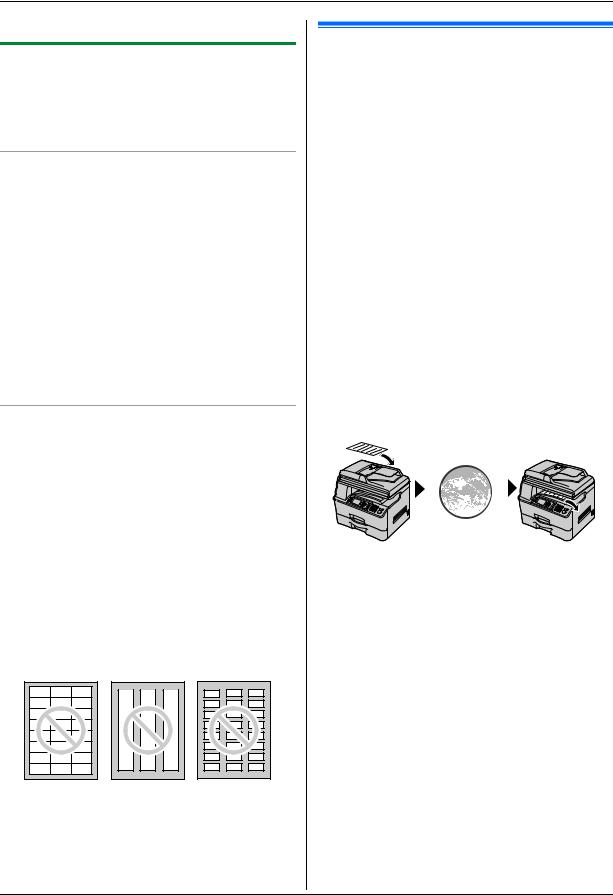
3. Printer
7 Click [Print] or [OK].
3.1.2 Printing on special media
You can print not only on plain paper but also on special media (transparencies / labels).
L Please refer to page 104 for information on recording paper.
L To load paper, see page 14.
To print on transparencies
Use transparencies designed for laser printing. We recommend the following:
3M® CG3300/CG5000
LDo not stack more than 25 transparencies at a time.
LAfter printing, place transparencies on a flat surface to cool and to prevent them from curling.
LDo not re-use transparencies that have already been fed through the unit. This includes transparencies that have been fed through and ejected without being printed on.
LSome types of transparencies have instructions recommending which side to print on. If the print quality is poor, try printing on the other side of a new transparency.
To print on labels
Use labels designed for laser printing. We recommend the following:
Avery® 5160/5161/5162/5163/5164/5165/5167/5168
XEROX® LWH100/LWH110/LWH120/LWH130/LWH140 L Make sure the print side is FACE UP when
loading the labels.
L Do not stack more than 25 labels at a time.
LDo not use the following types of labels:
–Labels that are wrinkled, damaged or separated from the backing sheet.
–Any sheet of labels that has spaces in it where some of the labels have been removed.
–Labels that do not completely cover the backing sheet as follows:
3.2 Printing a received email attachment automatically (LAN connection only)
If you configure the POP server settings beforehand, the unit will automatically print files attached to an email that are sent from a compatible unit via the Internet (scan to email print). This is useful if you want to print only attached files, without checking your emails.
Important:
L The unit does not print email messages.
LThe unit will only print attached files sent from a compatible unit, which can send emails directly (without using a computer).
LThe attachment file formats that can be printed are as follows:
–TIFF
–JPEG
–PDF (Image type only. Such as files scanned from the unit, files scanned from the
computer using Quick Image Navigator/MultiFunction Viewer, or received fax documents saved as an email attachment.)
LReceived emails and the attached files will be deleted automatically after printing.
A B C
ASend from a compatible multi-function unit (Example: “4.1.5 Scan to email address (LAN connection only)”, page 32)
B Email is sent via the Internet (email server) C Receiving unit prints attached files
1Start Multi-Function Station.
2[Utilities] i[Configuration Web Page] i [Network Configuration]
3Type “root” as the user name, then enter the password (feature #155 on page 58). i[OK]
4Click the [Scan to Email Print] tab.
5Set each item.
To activate this feature:
Select [Enabled] next to [Scan to Email Print]. i[Submit]
To set the email server information:
1.Click [Edit] next to [Email Server].
2.Enter the email server and POP server information. i[Submit]
29

3. Printer
6 Close the web browser.
Note:
LThis feature can be programmed only through the web browser interface (page 57).
LTo view the recent scan to email print information, click [List] next to [Email Print Log] (page 76).
LIf the attached file is too large or is in an unsupported format, it will not be printed properly.
LYou can change the email checking interval (page 76) or header print setting (page 76).
LConsult your service provider or network administrator for details.
30
